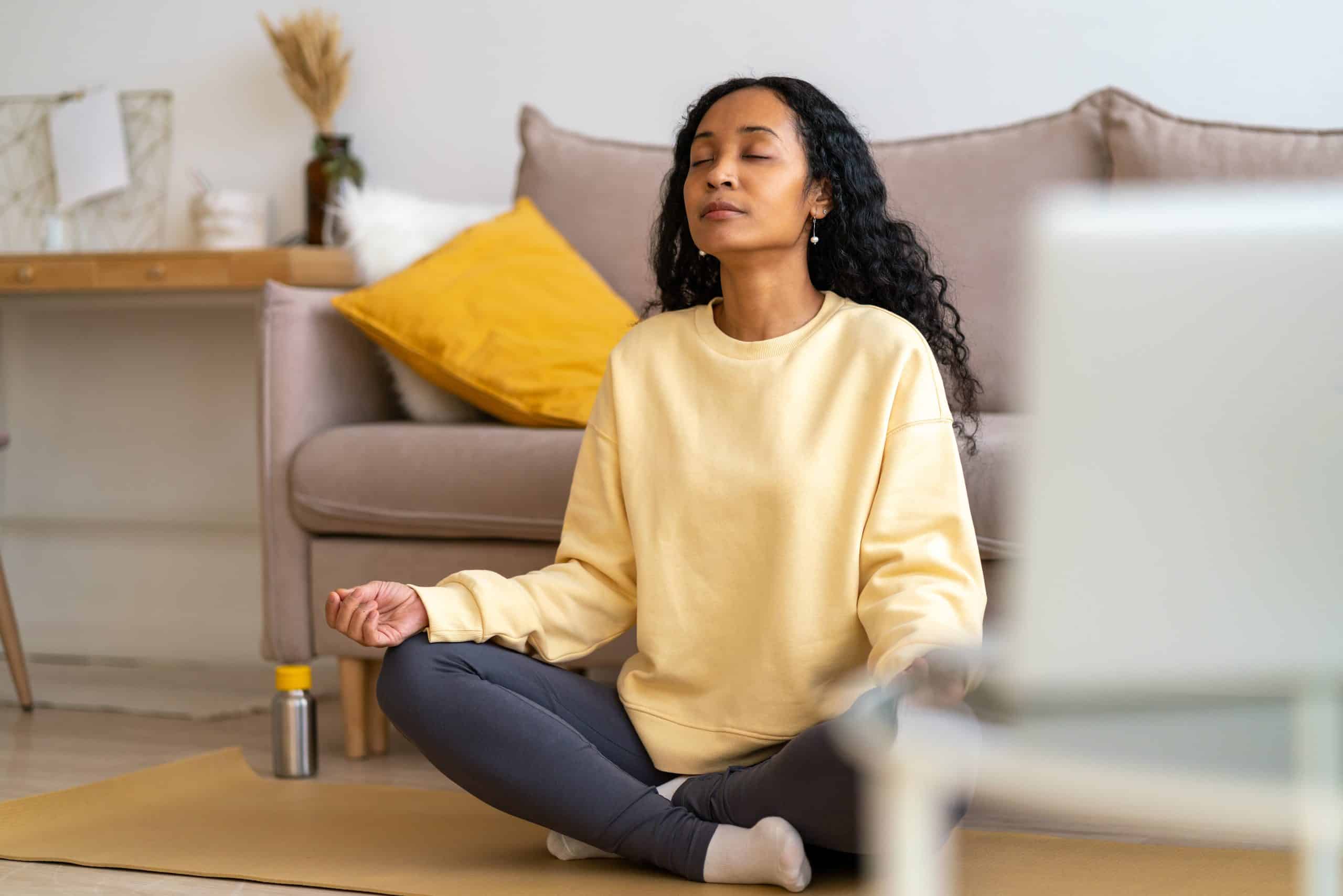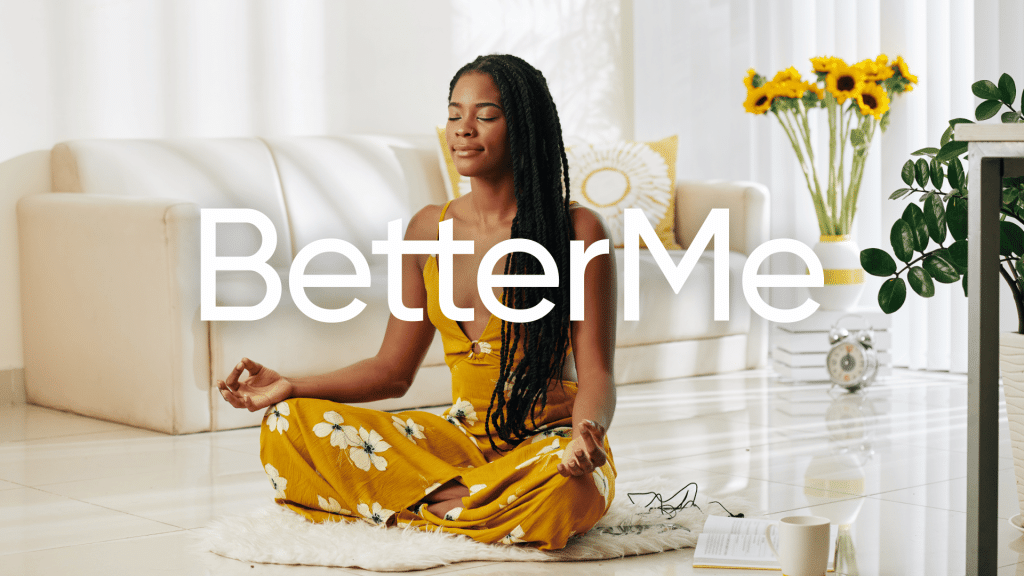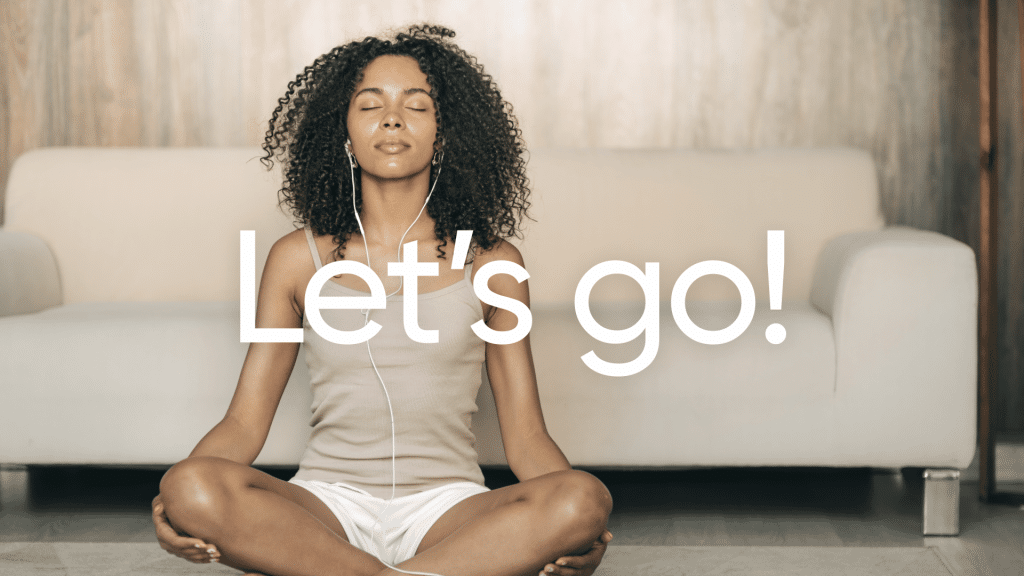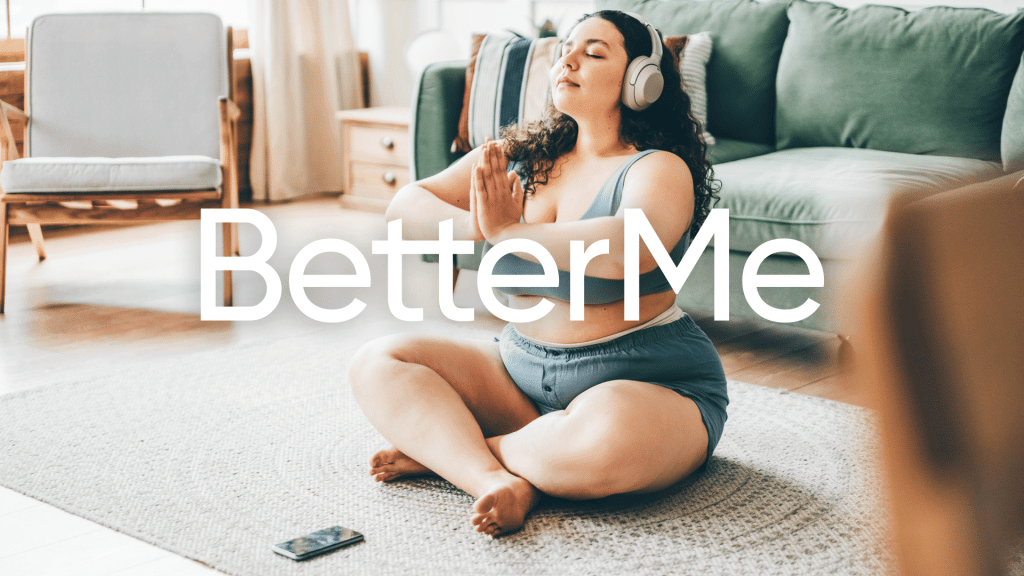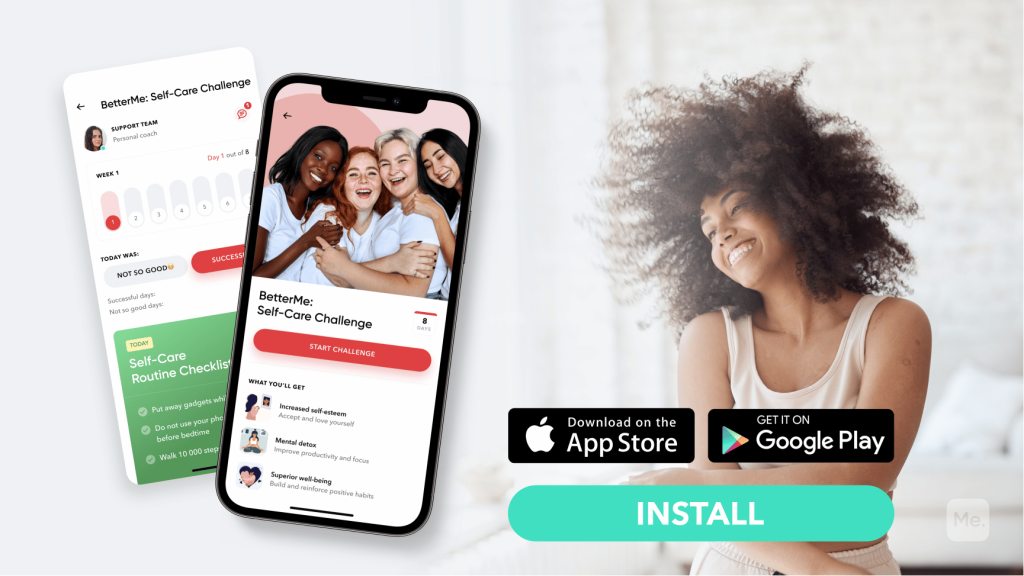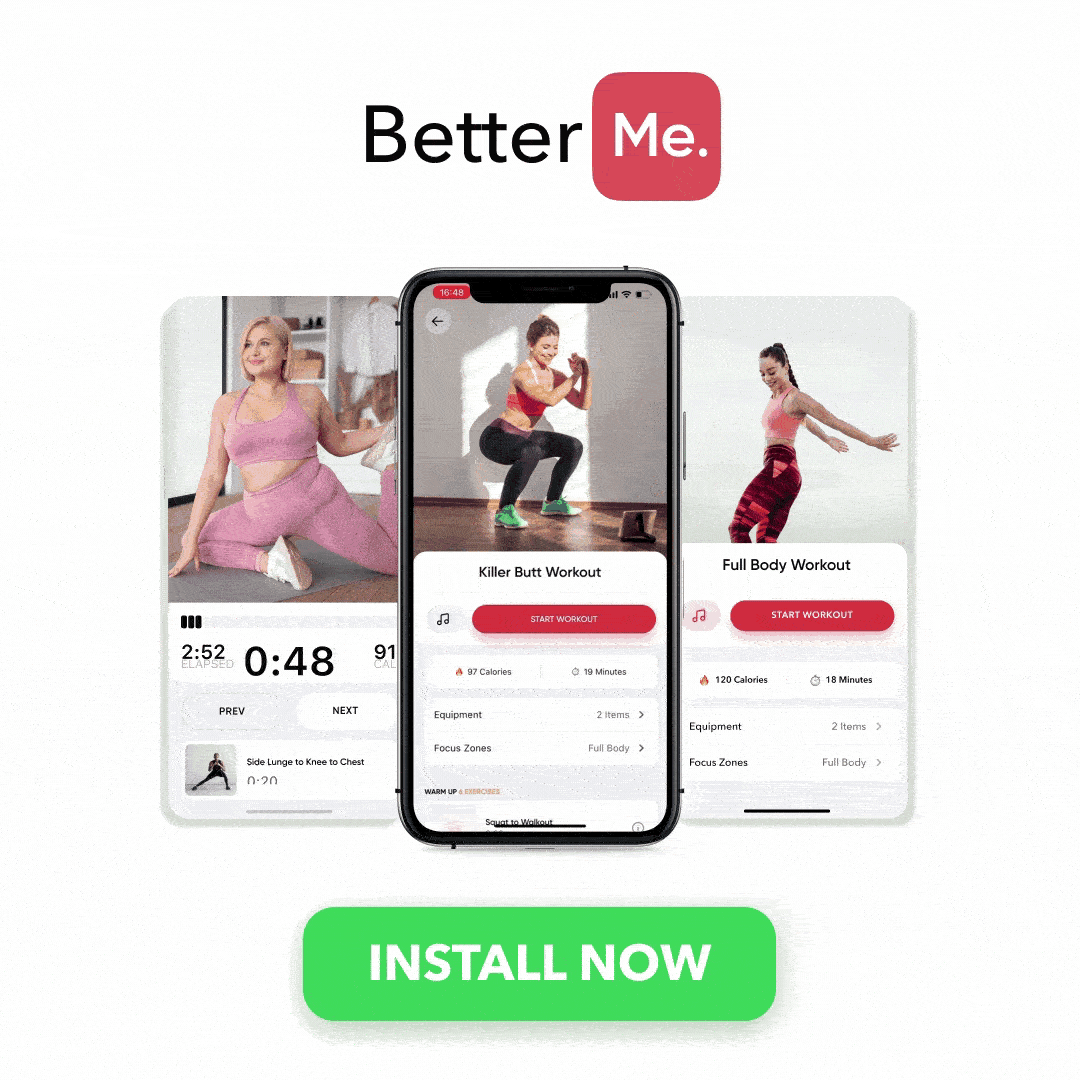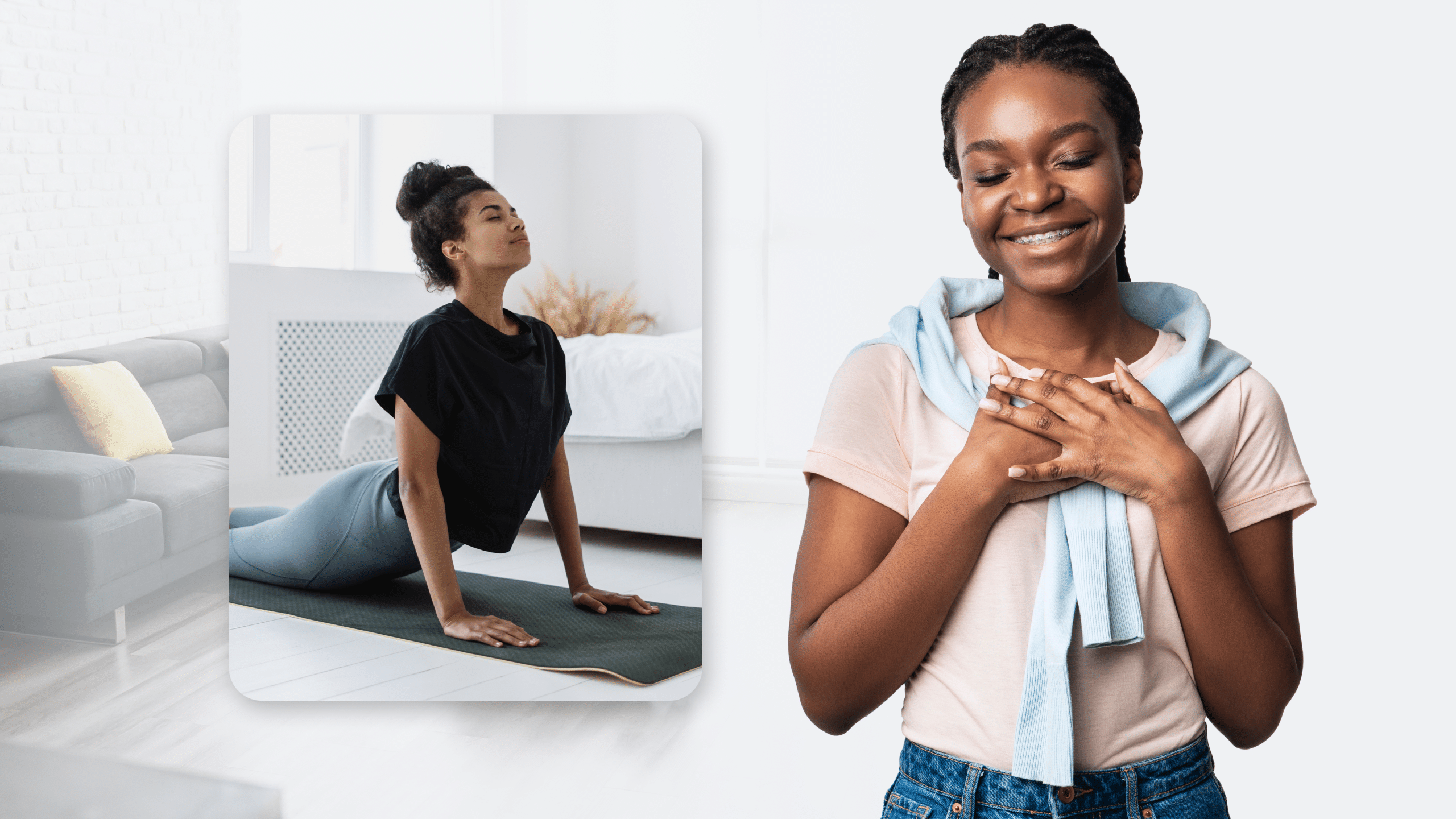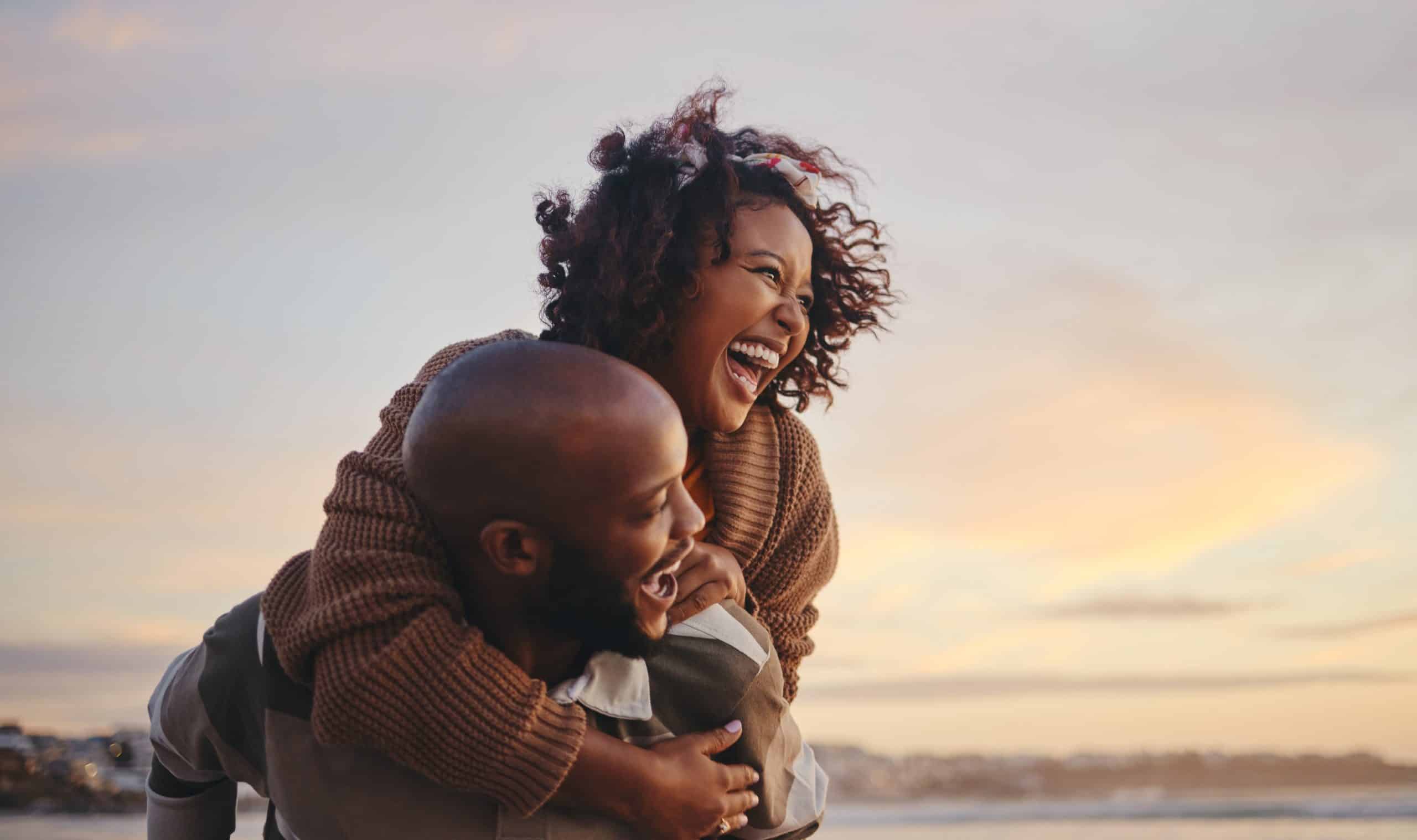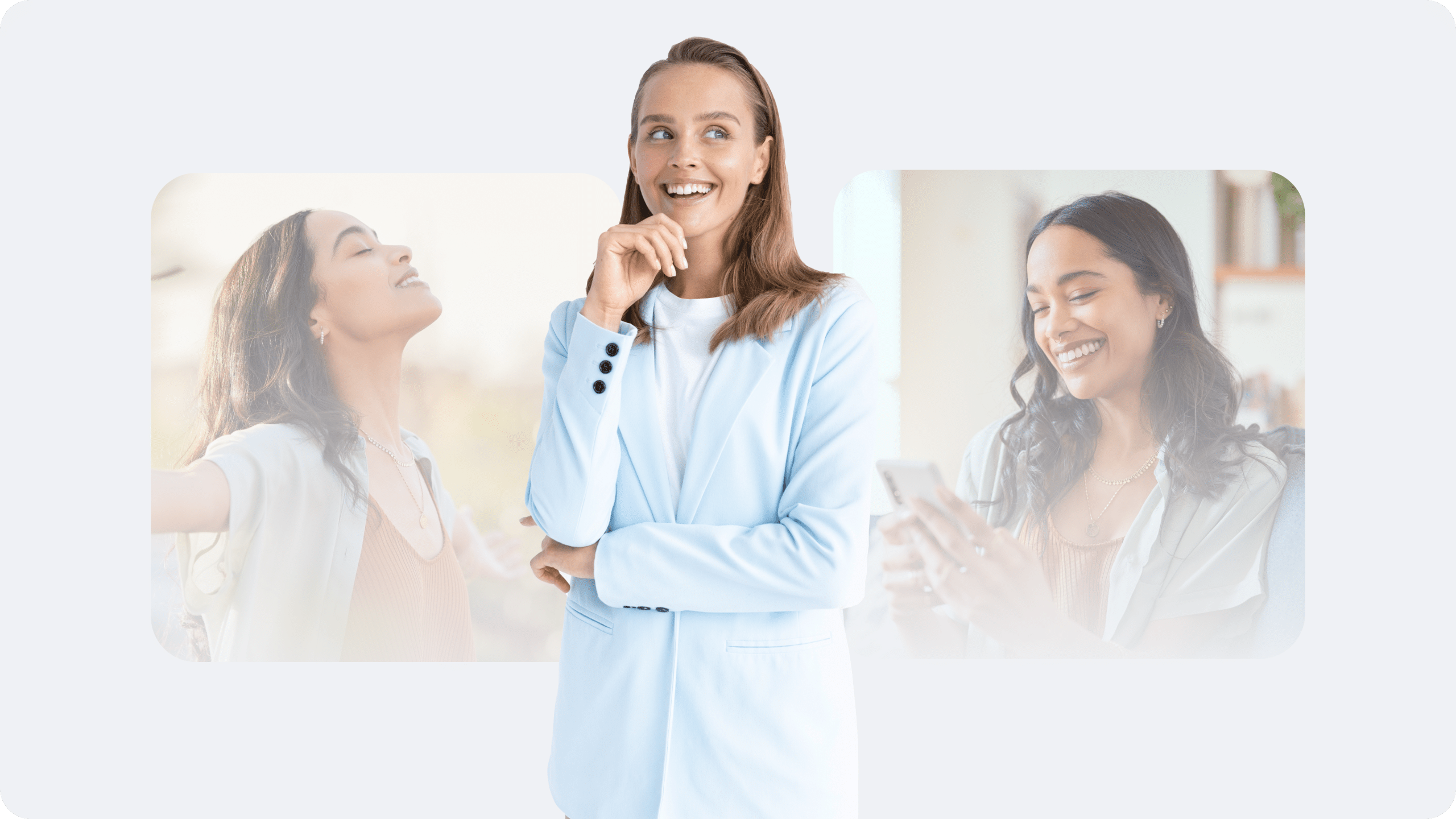At the core of any yoga practice (beginner, intermediate, or advanced) is the breath. In yoga, breathing is a way to connect with your body and promote healing on all levels – physical, mental, and emotional. Breathwork techniques can take this healing power to the next level by allowing you to consciously control your body’s response to stress and anxiety (13). That’s not all—research into the breath–health connection reveals that effective use of breathwork can be used to manage a number of health conditions, including pain management, mental clarity, and even healing. With these benefits in mind, it’s worth exploring the various types of breathwork and how they can be used to improve your health. Below, we list both beginner and advanced breathwork techniques, describe their origins, and explain how to use them for optimal health.
Basic Breathwork Techniques For Beginners
When you’re new to breathwork, it’s important to master the basics before trying any of the more advanced techniques. Here are all the popular breathwork methods that beginners should start with:
1. Dirga Pranayama (Diaphragmatic Breathing)
Perhaps the most popular and widely studied breathwork technique, diaphragmatic breathing helps regulate the breath by focusing on deep inhalations and exhalations.
It is also called belly or abdominal breathing because you focus on both inflating and deflating the stomach as you inhale and exhale, respectively.
To practice diaphragmatic breathing:
- Sit, stand, or lay down in a comfortable position.
- Place one hand on your chest and the other on your belly.
- As you inhale, focus on expanding your belly.
- Then, as you exhale, contract your stomach muscles and draw your navel in towards your spine.
- Repeat for a few minutes and focus on deepening each breath.
There’s some science behind diaphragmatic breathing (9):
- It helps stimulate the vagus nerve, which is involved in rest and relaxation. This may reduce stress, anxiety, and sleeplessness.
- It helps increase stamina for intense exercise.
- It helps improve the body’s natural ability to regulate the breath.
- It strengthens your diaphragm and core muscles.
Read More: 4 Simple Tips To Feel More Comfortable During Meditation With Pillows And Cushions
2. Sama Vritti Pranayama (Equal Breathing)
Equal breathing, or sama vritti pranayama, is a type of meditation and breathwork technique that focuses on even inhalations and exhalations. This technique encourages a slower, more controlled breath and helps reduce stress. It’s commonly referred to as circular breathing because it has a calming, circular rhythm.
To practice equal breathing:
- Sit in a comfortable position and close your eyes.
- Begin to inhale for a count of four, and then exhale for a count of four.
- As you breathe, focus on the movement of your diaphragm, chest, and abdomen.
- Continue to breathe in for a count of four and out for a count of four, repeating the cycle for a few minutes.
There is scientific evidence backing up equal breathing (12):
- It engages the parasympathetic nervous system and helps the body relax.
- It reduces stress and anxiety levels by balancing the heart rate.
- It can be used to manage pain and chronic conditions.
- It helps improve focus and concentration.
3. Nadi Shodhana Pranayama (Alternate Nostril Breathing)
This type of breathwork is designed to cleanse and purify the body and mind. It has its roots in yoga, and it is believed to help balance the left and right hemispheres of the brain.
The theory is that the right hemisphere controls creativity and intuition, while the left hemisphere is responsible for logic and reason. When you close off one nostril and breathe only through the other, you are said to be stimulating and balancing both hemispheres of the brain.
To practice alternate nostril breathing:
- Sit comfortably and close your eyes.
- Use your right thumb to close the right nostril and inhale through the left nostril.
- Then, close the left nostril with your right index finger and open the right nostril to exhale.
- Repeat the process, alternating between nostrils for a few minutes.
There is some scientific evidence to support the benefits of alternate nostril breathing (7):
- It helps reduce stress and fatigue.
- It can improve concentration and focus.
- It helps improve respiratory endurance
- It enhances overall physical and mental health.
Running a never-ending rat race, shoving trauma further and further away, falling into self-harming thought patterns, living life that’s eclipsed by constant anxiety and fear – this is what an average person goes through every day. Not addressing it will only pull you deeper into a downward spiral. BetterMe: Meditation & Sleep app will help you gain a new perspective on life and help you regain that long-lost internal balance!
4. Bhastrika Pranayama (Bellows Breath)
Bhastrika pranayama, also known as bellows breath, is a type of pranayama that involves fast and forceful breathing. The idea is to use your breath as a bellows (like a blacksmith’s bellows) to fill and empty your lungs as quickly as possible.
To practice bellows breath:
- Sit comfortably and close your eyes.
- Begin to inhale and exhale quickly, like a bellows.
- With each breath, focus on filling your lungs completely and then emptying them completely.
- Continue for a few minutes and focus on deepening your breath.
The scientific evidence backs up the benefits of bellows breath (4) (11):
- It helps to increase oxygenation in the body.
- It helps improve lung capacity and respiratory endurance.
- It helps reduce stress and anxiety levels.
- It increases energy and vitality in the body.
5. Kapalabhati Pranayama (Skull-Shining Breath)
Designed to purify and strengthen the body, Kapalabhati Pranayama is a breathwork practice that involves forceful exhalations and passive inhalations. By forcefully exhaling and drawing in the abdomen, this Pranayama helps to stimulate the entire body.
To practice skull-shining breath:
- Sit comfortably and close your eyes.
- Begin to exhale forcefully while contracting the abdomen, as if pushing out all of the air in the lungs.
- Relax the abdomen and inhale passively, allowing the breath to fill your lungs.
- Repeat for a few minutes, focusing on deepening your breath.
There’s limited, albeit encouraging, scientific evidence for the benefits of skull-shining breath (18):
- It helps reduce stress and anxiety.
- It helps improve focus and concentration.
- It helps increase energy levels and vitality.
- It can help improve physical strength and endurance.
6. Ujjayi Pranayama (Victorious Breath/Ocean Sounding Breath)
Ujjayi Pranayama is essentially audible breathing, or “ocean sounding breath.” It is a type of pranayama that focuses on slowly and deeply inhaling and exhaling through the mouth while making an audible “haaaa” sound.
To practice Ujjayi Pranayama:
- Sit comfortably and close your eyes. You may find it more comfortable to lean slightly forward, if desired.
- Begin to inhale deeply and slowly through the nose
- Contract your throat muscles, making a slight “haaaa” sound as you exhale. Imagine using your breath to fog up a mirror.
- Continue for a few minutes, focusing on deepening your breath.
- When you’ve mastered the basics, you can try exhaling while making the sound without opening your mouth.
There’s limited evidence to suggest that Ujjayi Pranayama offers certain benefits (15):
- It helps reduce stress and anxiety levels.
- It helps improve breathing capacity and endurance.
- It can help open the body’s energy channels, allowing for a deeper and more fulfilling practice.
- It helps improve focus and mental clarity.
7. Bhramari Pranayama (Humming Bee Breath)
Bhramari Pranayama, or humming bee breath, is a type of pranayama that involves inhaling and exhaling through the nose while making a humming sound. The idea is to use your breath to create a vibration in the body.
To practice Bhramari Pranayama:
- Sit comfortably and close your eyes.
- Begin to inhale deeply through the nose, feeling the breath expand into your belly.
- As you exhale, press your tongue against the roof of your mouth and make a humming sound.
- Continue for a few minutes, focusing on deepening your breath.
There’s some scientific evidence to suggest the benefits of Bhramari Pranayama (8):
- It helps reduce stress and anxiety levels.
- It helps clear the mind and improve focus.
- It helps calm the nervous system and promote relaxation.
- It helps open the body’s energy channels, allowing for a deeper and more fulfilling practice.
BetterMe: Meditation & Sleep app can help you transmute stress into serenity, pull you up from the doldrums, free your mind from the cares and worries of the world, quell racing thoughts and infuse you with tranquility! Start using it now and change your life!
8. Sheetali Pranayama (Cooling Breath)
Sheetali Pranayama is a cool-breathing exercise designed to reduce body heat. It’s a relatively simple practice that involves inhaling and exhaling slowly through the mouth while sticking out the tongue.
To practice Sheetali Pranayama:
- Sit comfortably and close your eyes.
- Begin to inhale slowly through the mouth, sticking out the tongue while forming an “O” shape with the lips.
- Slowly exhale through the nose, feeling the breath cool down the throat and lungs.
- Continue for a few minutes, focusing on deepening your breath.
There’s some scientific evidence to suggest the benefits of Sheetali Pranayama:
- It helps reduce stress and anxiety levels (14).
- It can help improve digestion.
- It helps reduce bodily heat, making it useful in hot climates or during exercise.
- It can help induce relaxation and promote better sleep.
9. Agnisar Kriya (Fire Purification Exercise)
Agnisar Kriya gets its name from “agni” (fire) and “sar” (purify). This exercise helps to purify the body by stimulating the digestive system. It is an excellent exercise for those who suffer from constipation, indigestion and other gastrointestinal problems (3).
To practice Agnisar Kriya:
- Sit comfortably and close your eyes.
- Place the palms of your hands on the sides of your belly, just above the navel.
- Inhale deeply and expand your abdomen outward with air.
- Then, exhale and draw your abdominal muscles inwards.
- Continue to alternate between drawing the abdomen inwards and pushing it outwards with each breath.
There’s some evidence to suggest the benefits of Agnisar Kriya:
- It helps improve digestion and elimination.
- It helps reduce stress and anxiety levels.
- It helps tone the abdominal muscles.
- It can help increase energy levels.
- It helps open the body’s energy channels, allowing for a deeper and more fulfilling practice.
- It helps improve focus and mental clarity.
- It can help induce relaxation and promote better sleep.
10. 4-7-8 Pranayama (Relaxing Breath)
As its name suggests, the 4-7-8 breathing technique is a three-step process that helps to relax your body and mind. It involves counting four seconds for the inhale, holding your breath for seven seconds, and then exhaling to the count of eight.
This breathing technique is based on ancient pranayama, a type of Yoga practice that focuses on breath control.
The ease of the 4-7-8 breathing technique makes it suitable for beginners, and for those looking for a way to quickly relax their body and mind.
To practice the 4-7-8 technique:
Sit comfortably and close your eyes.
- Place one hand on your belly and the other on your chest.
- Inhale deeply and slowly to the count of four, feeling your stomach expand outwards with air.
- Hold your breath for a count of seven.
- Exhale slowly and completely to the count of eight, feeling your stomach draw inwards.
- Repeat a few times and focus on deepening your breath with each repetition.
There’s some evidence to suggest the benefits of 4-7-8 Pranayama :
- It can help reduce stress and anxiety levels.
- It helps open the body’s energy channels, allowing for a deeper and more fulfilling practice.
- It can help induce relaxation and promote better sleep.
- It helps improve focus and mental clarity.
- It helps increase energy levels.
- It can help improve breathing capacity and reduce blood pressure (6) (10).
11. Pursed Lip Breathing
This is a breathing technique that can be done in a variety of ways, but generally involves inhaling slowly and deeply through the nose and then exhaling slowly and deliberately with pursed lips.
The idea behind pursuing the lips is to create back pressure which helps slow down the breath, allowing for a more controlled release of air.
To practice pursed lip breathing:
- Sit comfortably and close your eyes. You may also find it helpful to sit up straight.
- Inhale deeply and slowly through your nose, feeling your stomach expand outwards with air.
- Exhale slowly and deliberately with pursed lips, feeling your stomach draw inwards.
- Repeat a few times, focusing on deepening your breath with each repetition.
There’s some evidence to suggest the benefits of pursed lip breathing (17):
- It can help reduce stress and anxiety levels.
- It helps open the body’s energy channels, allowing for a deeper and more fulfilling practice.
- It can help induce relaxation and promote better sleep.
- It helps improve focus and mental clarity.
- It can help reduce shortness of breath, especially during exercise.
- It can help reduce the symptoms of respiratory conditions like COPD and asthma.
12. Box Breathing (4-4-4-4 Breathing)
This is another breathing technique that can be done in a variety of ways, but generally involves inhaling for four seconds, holding your breath for four seconds, exhaling for four seconds, and then holding your breath again for four seconds.
This technique is often referred to as “box breathing” because the regular pattern of breathing resembles a square or box.
To practice box breathing:
- Sit comfortably and close your eyes. You may also find it helpful to sit up straight.
- Inhale deeply for four seconds, feeling your stomach expand outwards with air.
- Hold this breath for four seconds.
- Exhale slowly and deliberately for four seconds, feeling your stomach draw inwards.
- Hold this breath for another four seconds and then repeat the cycle a few times.
Advanced Breathwork Techniques To Take Your Practice To The Next Level
There are also some more advanced breathwork techniques that require instruction from a professional and should only be practiced under the guidance of an experienced practitioner.
1. Wim Hof Breathing
This technique was developed by Dutch extreme athlete Wim Hof and combines rapid breathing with cold exposure. It involves a deep inhale, followed by a quick and forceful exhale, which is repeated in cycles of 30 to 40 breaths (5).
2. Holotropic Breathwork
This technique involves a combination of mindful breathing, body work and music in order to access altered states of consciousness. The idea is to use the breath to open up the body and induce a deep meditative state (1).
3. Rebirthing Breathwork
This technique was developed by psychologist Leonard Orr and involves deep, connected breathing intended to simulate the experience of being born. It is often done in combination with bodywork and guided imagery (16).
4. Shamanic Breathwork Meditation
This breathing technique combines rhythmic and connected breathing with music and other forms of meditation. It is intended to access the unconscious mind and create a deeper level of awareness (o).
By connecting with the breath, the practitioner can access memories and experiences that may have been forgotten.
5. Transformational Breathwork
This type of breathwork combines deep and conscious breathing with body work, visualization and music. It is intended to access the subconscious mind in order to make changes in the body and mind (2).
6. Clarity Breathwork
This technique involves deep, connected breathing with an emphasis on releasing trapped emotions and energy as well as reducing stress levels. It is often used to enhance clarity and peace of mind (19).
7. Vivation Breath
Developed by psychologist Gay Hendricks (also known as Conscious Breathing), this type of breathwork combines deep, connected breathing with a series of body movements .
It is intended to help the practitioner open up and access their own true power. It’s also designed to help people release physical and emotional tension (20).
8. Neurodynamic Breathwork
This type of breathwork is a form of self-therapy that utilizes deep and connected breathing combined with bodywork, music and guided visualization. It is designed to help the practitioner access the deeper levels of their subconscious and make changes to their mental, emotional, physical and spiritual wellbeing.
The Bottom Line
Breathwork can be a powerful tool for self-discovery and transformation. Research suggests that it may be helpful for reducing stress, improving mental clarity and enhancing wellbeing.
If you’re interested in exploring breathwork further, begin with basic techniques and work your way up to more advanced techniques. It’s important to practice under the guidance of an experienced practitioner in order to ensure a safe and beneficial experience.
DISCLAIMER:
This article is intended for general informational purposes only and does not address individual circumstances. It is not a substitute for professional advice or help and should not be relied on to make decisions of any kind. Any action you take upon the information presented in this article is strictly at your own risk and responsibility!
SOURCES:
- About Holotropic Breathwork® (n.d., holotropic.com)
- About Transformational Breath® (n.d., transformationalbreath.com)
- Can yoga be used to treat gastroesophageal reflux disease? (2013, ncbi.nlm.nih.gov)
- Changes in Lung Function Measures Following Bhastrika Pranayama (Bellows Breath) and Running in Healthy Individuals (2019, ncbi.nlm.nih.gov)
- Discover the science behind the Wim Hof Method (n.d., wimhofmethod.com)
- Effect of 4-7-8 Breathing Technique on Anxiety and Depression in Moderate Chronic Obstructive Pulmonary Disease Patients (2019, academia.edu)
- Effect of fast and slow pranayama on perceived stress and cardiovascular parameters in young health-care students (2013, ncbi.nlm.nih.gov)
- Effects of Bhramari Pranayama on health – A systematic review (2016, sciencedirect.com)
- Effects of Diaphragmatic Breathing on Health: A Narrative Review (2020, mdpi.com)
- Effects of sleep deprivation and 4‐7‐8 breathing control on heart rate variability, blood pressure, blood glucose, and endothelial function in healthy young adults (2022, onlinelibrary.wiley.com)
- Effects of Yoga Respiratory Practice (Bhastrika pranayama) on Anxiety, Affect, and Brain Functional Connectivity and Activity: A Randomized Controlled Trial (2020,frontiersin.org)
- Effects of yogic breath regulation: A narrative review of scientific evidence (2019, sciencedirect.com)
- How Breath-Control Can Change Your Life: A Systematic Review on Psycho-Physiological Correlates of Slow Breathing (2018, frontiersin.org)
- Impact of Sheetali and Sheetkari Pranayama on the Topographic Mapping of the Brain Waves (2014, researchgate.net)
- Inclusive Yoga : NCHPAD – Ujjayi Breathing (n.d., nchpad.org)
- LEONARD ORR | RebirthingBreathwork (n.d., rebirthingbreathwork.com)
- Pursed-lip Breathing (2022, ncbi.nlm.nih.gov)
- Study of immediate neurological and autonomic changes during kapalbhati pranayama in yoga practitioners (2022, ncbi.nlm.nih.gov)
- What is Clarity Breathwork? (n.d., claritybreathwork.com)
- What is Vivation (n.d., vivation.com)
